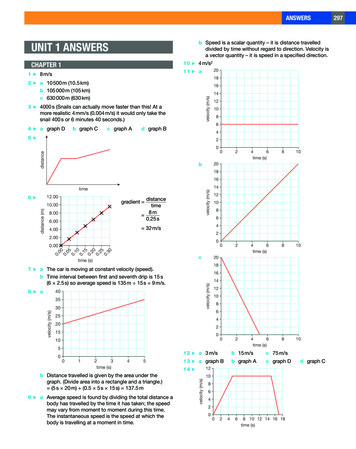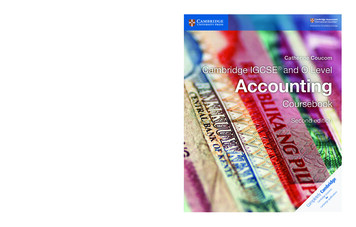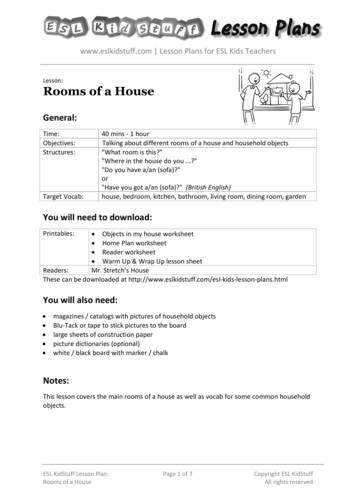
Transcription
ANSWERSb Speed is a scalar quantity – it is distance travelleddivided by time without regard to direction. Velocity isa vector quantity – it is speed in a specified direction.UNIT 1 ANSWERS10 4 m/s2CHAPTER 12011 a1 8 m/s182 a 10 500 m (10.5 km)b 105 000 m (105 km)c 630 000 m (630 km)16velocity (m/s)143 4000 s (Snails can actually move faster than this! At amore realistic 4 mm/s (0.004 m/s) it would only take thesnail 400 s or 6 minutes 40 seconds.)4 a graph Db graph Cc graph A121086d graph B45 2distance0b0246time (s)8100246time (s)8100246time (s)8102018161412.006 distancegradient time8m 0.25 s10.00distance (m)velocity (m/s)time8.006.001210864 32 m/s4.0022.00030250.200.150.100.050.0.0.000.00ctime (s)187 a The car is moving at constant velocity (speed).b Time interval between first and seventh drip is 15 s(6 2.5 s) so average speed is 135 m 15 s 9 m/s.1614velocity (m/s)8 a40353012108625420215010500123time (s)45b Distance travelled is given by the area under thegraph. (Divide area into a rectangle and a triangle.) (5 s 20 m) (0.5 5 s 15 s) 137.5 m9 a Average speed is found by dividing the total distance abody has travelled by the time it has taken; the speedmay vary from moment to moment during this time.The instantaneous speed is the speed at which thebody is travelling at a moment in time.12 a 3 m/sb 15 m/sc 75 m/s13 a graph Bb graph Ac graph D1214 10velocity (m/s)velocity (m/s)208642002468 10 12 14 16 18time (s)d graph C297
298 ANSWERS1215 avelocity (m/s)108642002468 10 12 14 16 18time (s)b 2.5 m/s2c i 20 mii 50 md average speed total distance travelled time taken. 70 m 9 s 7.78 m/s16 The total distance travelled increases with the squareof the time from the start, 0.5 m after 1 s, 2.0 m after2 s, 4.5 m after 3 s, etc. Calculating the average velocityover each 1 s time interval (between the drips) and thenplotting a graph of average velocity against time allowsthe acceleration to be calculated from the gradient of thegraph. The acceleration is 1 m/s2.6 a Without friction, objects would not be able to startmoving from a stationary position, or stop movingwhen in motion. It would not be possible to buildthings because it would be difficult to pick up thebuilding materials, and structures rely on friction toremain intact.b Any two sensible examples, such as: walking wouldbe impossible without friction acting between yourfeet and the ground; climbing a rope would beimpossible without friction acting between your handsand the rope.friction7 friction8 normal reaction forcepull of caron caravanairresistance17 a Student answer will varyb 32 mweightnormal reaction forceCHAPTER 2forward forcefrom engine1 a gravityb frictionc normal reaction or contact forceb 1250 Nreaction4 c 50 Nd redfrictionweightreaction from ground actingupwards at each wheel5 airresistanceweight2 Friction and air resistance (or viscous drag)3 a 1200 Npull ofcaravanon car9 aLoad force onspring (newtons)Length ofspring (cm)Extension ofspring 2.97.9b c (d – red line)14air resistance1210weightreactionload (N)forward thrustfrom friction ofroad on the wheels8Hooke’s6 LawThe graph for theelastic band willlook like this4thrustair resistanceweight200246extension (cm)8
ANSWERSCHAPTER 31 A force that is not balanced by a force in the oppositedirection. An accelerating car has an unbalanced forcewhen the forwards force from the engine is bigger thanthe backwards force from air resistance.2 From the equation force mass acceleration (F ma) wecan see that if F, the thrust force of the rocket engines, isconstant and m, the mass of the rocket, decreases thenthe acceleration must increase.3 a F ma, where mass 0.5 kg and acceleration 4 m/s2So F 0.5 kg 4 m/s2 2 Nb m F a, where force 200 N and acceleration 0.8 m/s2So m 200 N 0.8 m/s2 250 kgc Use a F m, where force 250 N and mass 25 kgSo a 250 N 25 kg 10 m/s24 a Thinking distance is the distance a car travels afterthe driver has seen a hazard but before the driverapplies the brakes; during this period the car is notdecelerating.b The braking distance is the distance travelled by thecar after the driver has started braking and the car isdecelerating to rest.c The overall stopping distance is the sum of thethinking distance and the braking distance.5 The braking distance of a car depends on the speed thatthe car is travelling and the braking force that can beapplied without the car skidding (as skidding means thecar is out of control). The maximum braking force will belimited by factors that affect the friction between the cartyres and the road surface: the condition of the tyres andthe road surface – if the road surface is wet, icy or oilyfriction will be reduced. The braking distance is greater ifeither the speed of the car is higher or the maximum safebraking force is reduced.6 a 0.75 s (the period during which the velocity of the caris constant at 24 m/s)b 18 m (given by the area under the velocity–time graphduring the first 0.75 s)c 2.5 s (the period during which the velocity of the car isdecreasing to zero)d 48 m (the sum of the thinking distance and the brakingdistance – the total area under the graph)7 a Use weight mass gravitymass of apple in kg 0.1 kgstrength of gravity on the Earth is approximately10 N/kgweight of apple on the Earth 0.1 kg 10 N/kg 1 Nb Use weight mass gravitymass of apple in kg 0.1 kgstrength of gravity on the Moon is approximately1.6 N/kgweight of apple on the Moon 0.1 kg 1.6 N/kg 0.16 N8 The factors affecting the drag force on a high-speedtrain are: the speed of the train the shape of the train the direction of any wind that may be blowing (harder) the viscosity of the air that it is travellingthrough; this will depend on temperature, humidity,etc.9 See page 36 for description of a suitable experiment.10 At A: velocity is zero at start, so air resistance is zeroand the unbalanced force is downwards (and is due togravity or the weight of the parachutist).At B: as the velocity of the parachutist increases sodoes the size of the upward air resistance force – so theunbalanced downwards force is smaller.At C: here the velocity of the parachutist has increasedto the point where the upward air resistance force isexactly the same as the downward force of gravity onthe parachutist – the unbalanced force is zero and theparachutist has reached terminal velocity.At D: the parachutist has opened her parachute at thistime. This greatly increases the upward air resistanceforce so the unbalanced force on the parachutist is nowupwards – so the parachutist’s velocity decreases.At F: as the parachutist slows down, the upward airresistance force due to the parachute decreases.This means that the unbalanced upward force issmaller. (So the rate of deceleration of the parachutistdecreases.)At G: the parachutist has slowed to a velocity at whichthe upward acting air resistance is once again equal tothe downward acting force of gravity. The unbalancedforce is again zero. (But note that the effect of openingthe parachute is to make the new terminal velocity lower.)CHAPTER 41 All three examples use the formula momentum mass velocity.a 48 kg m/sb 150 000 kg m/sc 3 kg m/s (Remember to express the mass in kilogramsand the velocity in m/s, thus: 0.06 kg 50 m/s)2 a momentum of truck with pellet after the collision 0.102 kg 0.8 m/s 0.0816 kg m/sb momentum of pellet before the collision 0.002 kg v(where v is the velocity we are trying to find.)c Since the momentum of truck before the collisionis zero because the truck is stationary and themomentum before and after the collision is the same0.002v 0.0816 kg m/s the velocity, v, of the pellet is40.8 m/sd This assumes that no other forces (like friction) act inthe line of travel of the pellet and the truck.3 a increase in momentum (impulse) F t 10 000 N 60 sso the increase in momentum is 600 000 kg m/s299
300 ANSWERSCHAPTER 51 a B has the largest turning moment, having the biggestforce applied at the greatest perpendicular distancefrom the pivot.b A shows the situation with the least turning momentbecause the 10 N force is applied at a perpendiculardistance from the pivot that is clearly less than half theperpendicular distance of the lines of action of the 5 Nforce in C and D.2 a C is balanced as the clockwise moment is equal to theanticlockwise moment.b B tips down to the right, clockwise moment 400 Nm,anticlockwise moment 375 Nmc D tips down to the left, clockwise moment 350 Nm,anticlockwise moment 375 Nmd A tips down to the left, clockwise moment 250Nm,anticlockwise moment 375 Nm3 a Pv 60 m2/s2 7.75 m/s (1)You need to find the answer to iii first!iii Time for the tennis ball to reach the ground,t (v – u)/a (1)t 7.75 m/s 10 m/s2 0.775 s (1)ii Average speed distance travelled time taken (1)Average speed 3 m 0.775 s 3.87 m/s (1)d From the area beneath the graph line (1)e 34 ofThe book isthe way between P and Q. 41 of itsweight will be on P, and 34 on Q, so P supports 2.5 Nand Q supports 7.5 N.d The weight of the shelf is spread evenly along theshelf, so each support takes half the weight (5 N).So with one 10 N book in the middle of the shelf, thereis 10 N on each support. With the book 50 cm from Q,there is a force of 7.5 N on P and 12.5 N on Q.END OF UNIT 1 QUESTIONS1 a Bb Dc Ad C (4)2 a B (1)b i Displacement is distance travelled in a specifieddirection. Distance is how far you have travellednot taking changes in your direction of travel intoaccount. (2)timearea 3 mttimearea 1 m2 marks for shape showing acceleration and abruptchange in direction, 1 mark for value of t as calculatedin c iii, 1 mark for labelling area of larger triangle 3 m,1 mark for labelling area of smaller triangle 1 m, and 1mark for stating that the gradient of both line segmentsis the acceleration due to gravity taken as 10 m/s2.bcQtgradient of both line segments 10 m/s2b 5 N on each support (this answer ignores the weight ofthe shelf itself).cParea 1 marea 3 m3 aQ1 m vertically above the ground (1)The ball falls with an acceleration downwards,a 10 m/s2 (1)The downward displacement of the ball onreaching the ground s 3 m (1)The ball had an initial velocity, u 0 m/s (1)So v2 u2 2as gives v2 02 2 10 m/s2 3m (1)velocity4 a No, the air bag slowly deflates as the driver collideswith it.b When a mass, like a person in a crashing car, is broughtrapidly to a halt, it is subject to a large deceleration.This large deceleration means that the mass must besubject to a huge force. Large forces result in damage.The air bag deflates slowly so the time for the driverto come to a halt is extended – this means that thedeceleration, and therefore the forces acting on thedriver during the deceleration, are reduced.iic ivelocityb increase in momentum mass increase in velocityso the increase in velocity 600 000 kg m/s 1200 kg 500 m/sThe new velocity is, therefore, 2500 m/s (initial velocityplus the increase in velocity).dThe left-hand sketch graph assumes that up is positivefor velocity; the right-hand sketch graph assumes thatdown is positive for velocity.i The load force on the wire (from the number ofweights). (1)ii The extension in length. (1)iii Temperature (or type of wire, or diameter of wire,or initial length of wire under test). (1)Using F mg (1)(1) mark for each point in italics and (1) mark for anyother from this list (max 5 marks):Note type of wireMonitor temperature during experimentMeasure diameter of wire under test with micrometerMeasure the extension produced by a range ofincreasing load forcesMeasure the extension produced by the same loadforces as the wire is unloadedPlot a graph of extension against load forceDraw the best fit line through the plotted pointsIf best fit line is a straight line through the origin of theaxes then wire obeys Hooke’s lawThe student also wants to know if the sample behaveselastically. Explain how the student can improve theinvestigation and discover whether or not the wirebehaves elastically
ANSWERS4 a The momentum of an object is the product of themass of the object and its velocity. Velocity is speedin a particular direction and is, therefore, a vectorquantity. This means that momentum also has bothsize and a specific direction and is therefore also avector quantity. (3)b Both gliders are at rest so the initial momentum iszero. (1)upward force from air flowc i(4)magnetic forceof repulsiontension in threadconnecting A to Bweight of gliderNewton’s third law states that for every actionthere is an equal and opposite reaction. Thismeans that glider A experiences an unbalancedmagnetic force to the left from B and glider Bexperiences an unbalanced magnetic force to theright from A and that each of these forces is thesame size. (3)iii Each glider experiences an unbalanced forcewhich causes them to accelerate away from eachother. (1)d i speed distance travelled time taken, speed 5cm 1.25 stherefore speed is 4 cm/s (2)ii The momentum of A to the left 500 g 4 m/sThis is equal to the momentum of glider B to theright since the total momentum of the glidersremains zeroThe momentum of B to the right 800 g v m/s so800 g v m/s 500 g 4 m/sTherefore v 2.5 cm/s (5)e If the magnets are closer together, the repelling forcebetween them will be greater so the accelerationof each glider after the thread is cut will be greatercausing the gliders to move apart more quickly.However, glider A, with a smaller mass than B, willmove faster as shown in the above calculation. (3)iiUNIT 2 ANSWERSCHAPTER 61 a 3Wb 50 Vc 0.26 Ad 100 W 18 000 s 1 800 000 J (1800 kJ)2 a The kettle is designed for a voltage of 230 V. At thisvoltage, 1.5 kJ of electrical energy is transferred intoheat energy each second.P 1500 Wb I
300 ANSWERS. ii1 m vertically above the ground (1) c iThe ball falls with an acceleration downwards, a 10 m/s2(1) The downward displacement of the ball on reaching the ground s 3 m (1) The ball had an initial velocity, u 04 m/s (1) So v2 u 2as gives v2 0 2 10 m/s 3m (1) v .











